Unravelling the Probabilistic Forest: Arbitrage in Prediction Markets (2508.03474v1)
Abstract: Polymarket is a prediction market platform where users can speculate on future events by trading shares tied to specific outcomes, known as conditions. Each market is associated with a set of one or more such conditions. To ensure proper market resolution, the condition set must be exhaustive -- collectively accounting for all possible outcomes -- and mutually exclusive -- only one condition may resolve as true. Thus, the collective prices of all related outcomes should be \$1, representing a combined probability of 1 of any outcome. Despite this design, Polymarket exhibits cases where dependent assets are mispriced, allowing for purchasing (or selling) a certain outcome for less than (or more than) \$1, guaranteeing profit. This phenomenon, known as arbitrage, could enable sophisticated participants to exploit such inconsistencies. In this paper, we conduct an empirical arbitrage analysis on Polymarket data to answer three key questions: (Q1) What conditions give rise to arbitrage (Q2) Does arbitrage actually occur on Polymarket and (Q3) Has anyone exploited these opportunities. A major challenge in analyzing arbitrage between related markets lies in the scalability of comparisons across a large number of markets and conditions, with a naive analysis requiring $O(2{n+m})$ comparisons. To overcome this, we employ a heuristic-driven reduction strategy based on timeliness, topical similarity, and combinatorial relationships, further validated by expert input. Our study reveals two distinct forms of arbitrage on Polymarket: Market Rebalancing Arbitrage, which occurs within a single market or condition, and Combinatorial Arbitrage, which spans across multiple markets. We use on-chain historical order book data to analyze when these types of arbitrage opportunities have existed, and when they have been executed by users. We find a realized estimate of 40 million USD of profit extracted.
Summary
- The paper introduces an LLM-based framework to detect market dependencies and quantify arbitrage opportunities in decentralized prediction markets.
- It demonstrates significant variances with single-condition arbitrage showing a median profit of $0.60 per dollar and distinct market-level strategies.
- The study highlights challenges such as non-atomic execution risk and LLM input limitations, while pointing to future research on improved market design.
Arbitrage Dynamics in Decentralized Prediction Markets: An Empirical Study of Polymarket
Introduction
This paper presents a comprehensive empirical analysis of arbitrage in decentralized prediction markets, focusing on Polymarket, a leading blockchain-based platform. The authors address three central questions: (Q1) the conditions under which arbitrage arises, (Q2) the actual occurrence of arbitrage on Polymarket, and (Q3) the exploitation of these opportunities by market participants. The paper leverages on-chain order book data, advanced prompt engineering for LLMs, and a formal taxonomy of market dependencies and arbitrage types to systematically identify and quantify arbitrage opportunities and their realization.
Prediction Market Structure and Resolution
Polymarket operates on the Polygon blockchain, utilizing ERC-1155 conditional tokens to represent binary outcomes ("YES"/"NO") for each market condition. Markets are constructed to be exhaustive and mutually exclusive, ensuring that the sum of probabilities across all conditions should be unity. Market creation is centralized, with conditions vetted for logical coherence. Resolution is managed via UMA's Optimistic Oracle, introducing potential governance and resolution risks, particularly in ambiguous or multi-faceted events.
Taxonomy of Market Dependencies and Arbitrage
The authors formalize market dependencies using combinatorial outcome spaces. For a single market, the outcome space is defined by mutually exclusive conditions; for multiple markets, dependencies are characterized by logical relationships between condition subsets, reducing the joint outcome space below the product of individual market spaces. Two primary arbitrage types are defined:
- Market Rebalancing Arbitrage: Occurs when the sum of "YES" token prices deviates from unity within a market, enabling risk-free profit via long (sum < 1) or short (sum > 1) strategies.
- Combinatorial Arbitrage: Arises across dependent markets when portfolio construction guarantees at least one winning position due to logical dependencies.
LLM-Based Detection of Market Dependencies
A key methodological contribution is the use of LLMs (DeepSeek-R1-Distill-Qwen-32B) with prompt engineering to infer semantic dependencies between market conditions. The approach involves generating exhaustive outcome tables for market pairs, validating logical exclusivity and dependency. Due to LLM context limitations, markets with more than four conditions are reduced to the most liquid conditions plus an aggregate "other" condition, preserving dependency structure while maintaining tractability.
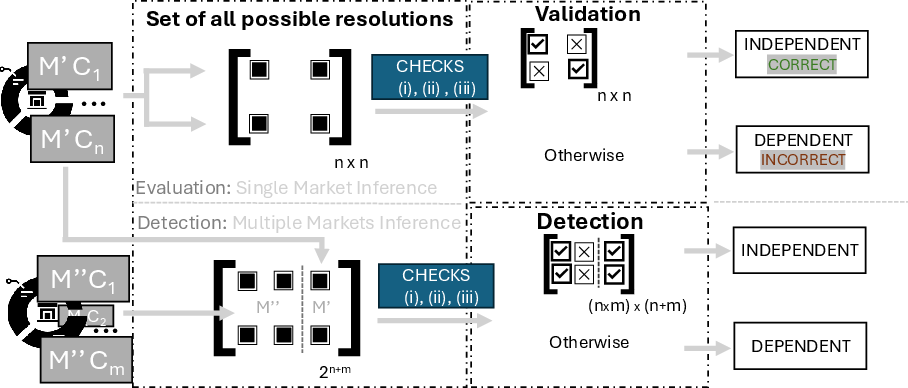
Figure 1: Schematic of the LLM-based pipeline for detecting market dependencies and arbitrage opportunities.
Empirical validation shows high accuracy in dependency detection for single markets, with reduced performance as condition count increases. For the 2024 U.S. election, 13 market pairs were identified as strictly dependent, suitable for combinatorial arbitrage analysis.
Empirical Analysis of Arbitrage Opportunities
Data Collection and Market Overview
The dataset spans one year of Polymarket activity, encompassing 8659 single-condition and 1578 multi-condition (NegRisk) markets, totaling 17,218 conditions. Politics and sports dominate market topics, with the U.S. election period exhibiting peak liquidity and trading volume.
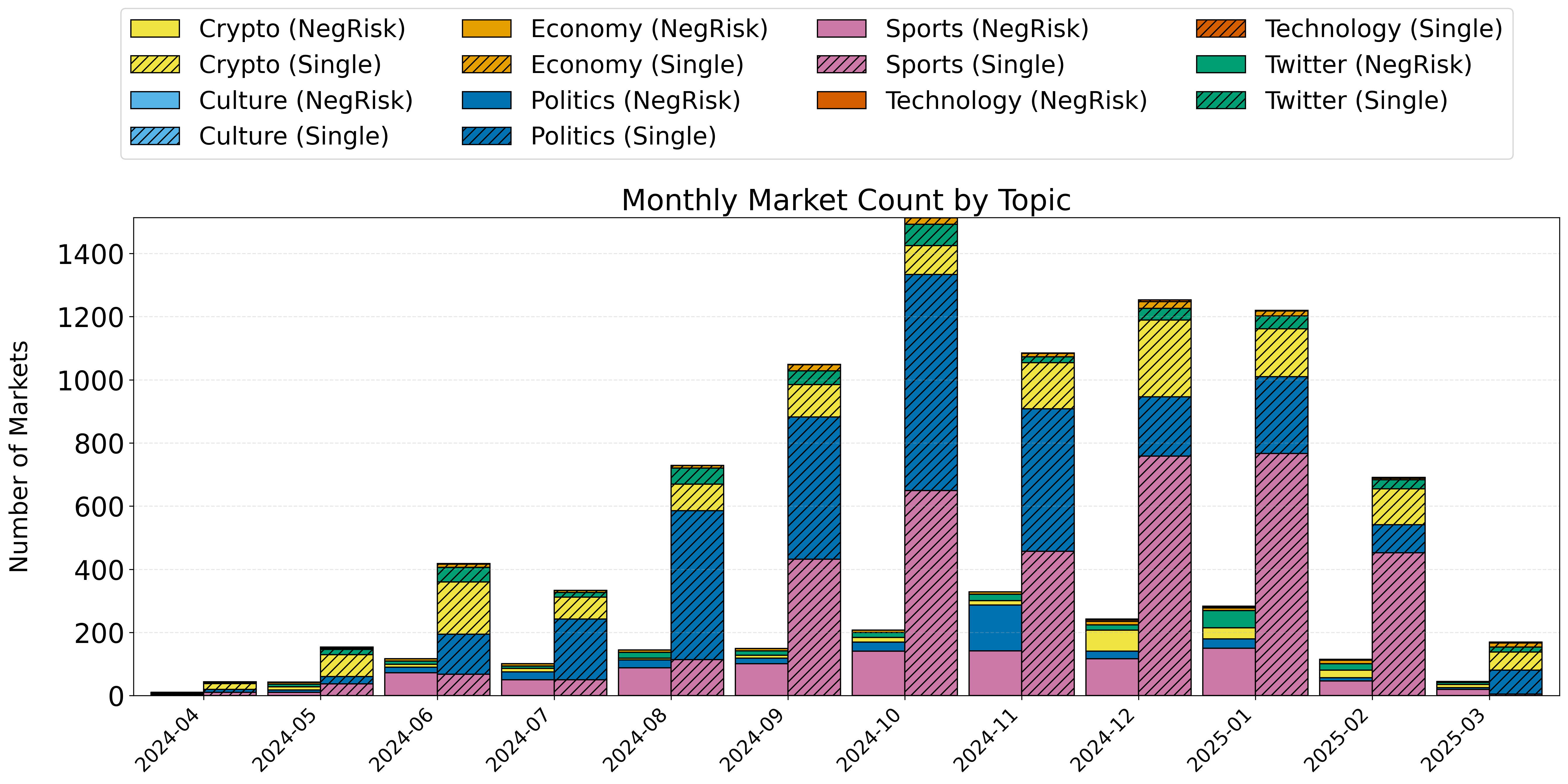
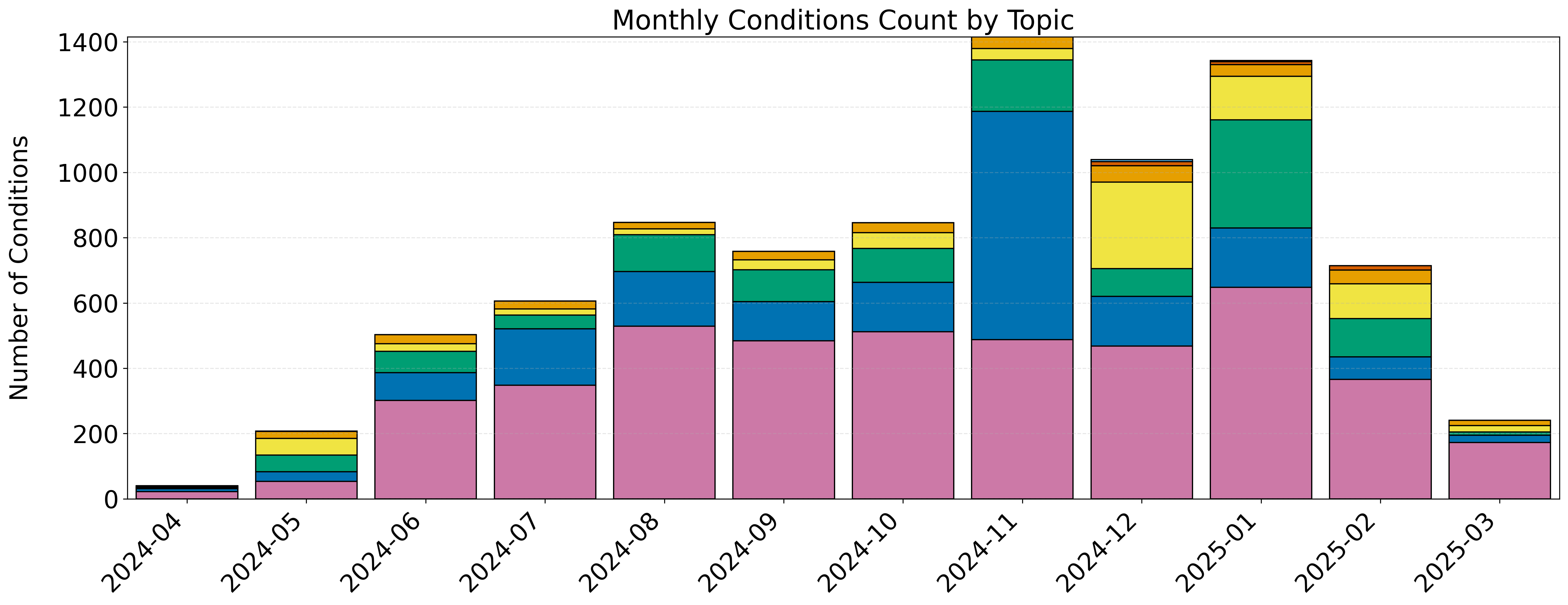
Figure 2: Distribution of market topics and condition counts over time, highlighting the dominance of politics and sports.
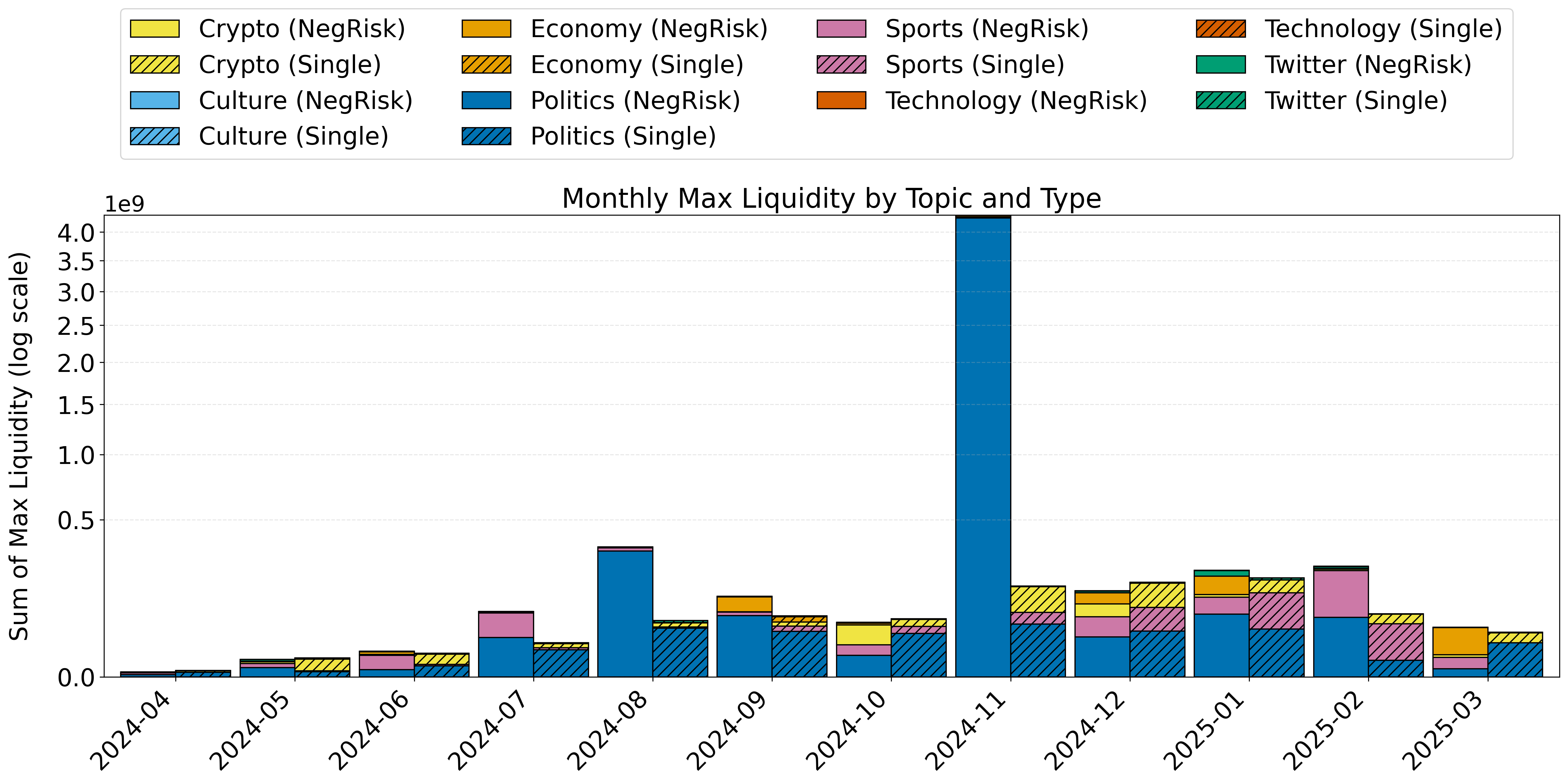

Figure 3: Liquidity and trading volume trends, with U.S. election markets driving activity spikes.
Arbitrage Detection Within Conditions and Markets
Arbitrage opportunities are detected by analyzing VWAP prices for each condition and market, focusing on periods of high uncertainty (no token > $0.95) and minimum profit thresholds ($0.05 per dollar). The analysis reveals:
- Single Condition Arbitrage: 7,051 conditions exhibited arbitrage, predominantly long opportunities, with median profit per dollar around $0.60, indicating substantial market inefficiency.
<img src="https://emergentmind-storage-cdn-c7atfsgud9cecchk.z01.azurefd.net/paper-images/2508-03474/condition_sum_over_time.png" alt="Figure 4" title="" class="markdown-image">
<p class="figure-caption">Figure 4: Time series of VWAP prices and detected arbitrage in the "Will Assad remain President of Syria through 2024?" market.</p>
<img src="https://emergentmind-storage-cdn-c7atfsgud9cecchk.z01.azurefd.net/paper-images/2508-03474/condition_arbitrage_col_num_ops_b_0.95_c_0.02_k_1_colums.png" alt="Figure 5" title="" class="markdown-image"></li>
</ul>
<p><img src="https://emergentmind-storage-cdn-c7atfsgud9cecchk.z01.azurefd.net/paper-images/2508-03474/condition_arbitrage_col_median_dev_b_0.95_c_0.02_k_1_colums.png" alt="Figure 5" title="" class="markdown-image"></p>
<p><img src="https://emergentmind-storage-cdn-c7atfsgud9cecchk.z01.azurefd.net/paper-images/2508-03474/condition_arbitrage_col_max_profit_long_b_0.95_c_0.02_k_1_colums.png" alt="Figure 5" title="" class="markdown-image">
<p class="figure-caption">Figure 5: Distribution of arbitrage opportunities within single conditions, with crypto markets showing significant outliers.</p>
<img src="https://emergentmind-storage-cdn-c7atfsgud9cecchk.z01.azurefd.net/paper-images/2508-03474/condition_arbitrage_bar_col_max_profit_long_b_0.95_c_0.02_k_1_colums.png" alt="Figure 6" title="" class="markdown-image"></p>
<p><img src="https://emergentmind-storage-cdn-c7atfsgud9cecchk.z01.azurefd.net/paper-images/2508-03474/condition_arbitrage_bar_col_max_profit_long_100_b_0.95_c_0.02_k_1_colums.png" alt="Figure 6" title="" class="markdown-image">
<p class="figure-caption">Figure 6: Aggregate arbitrage potential per condition, uncapped and capped at $100 liquidity, showing politics and sports as lucrative domains.
- Market-Level Arbitrage: 662 NegRisk markets had arbitrage, with sports markets consistently offering higher profit, especially in long opportunities.
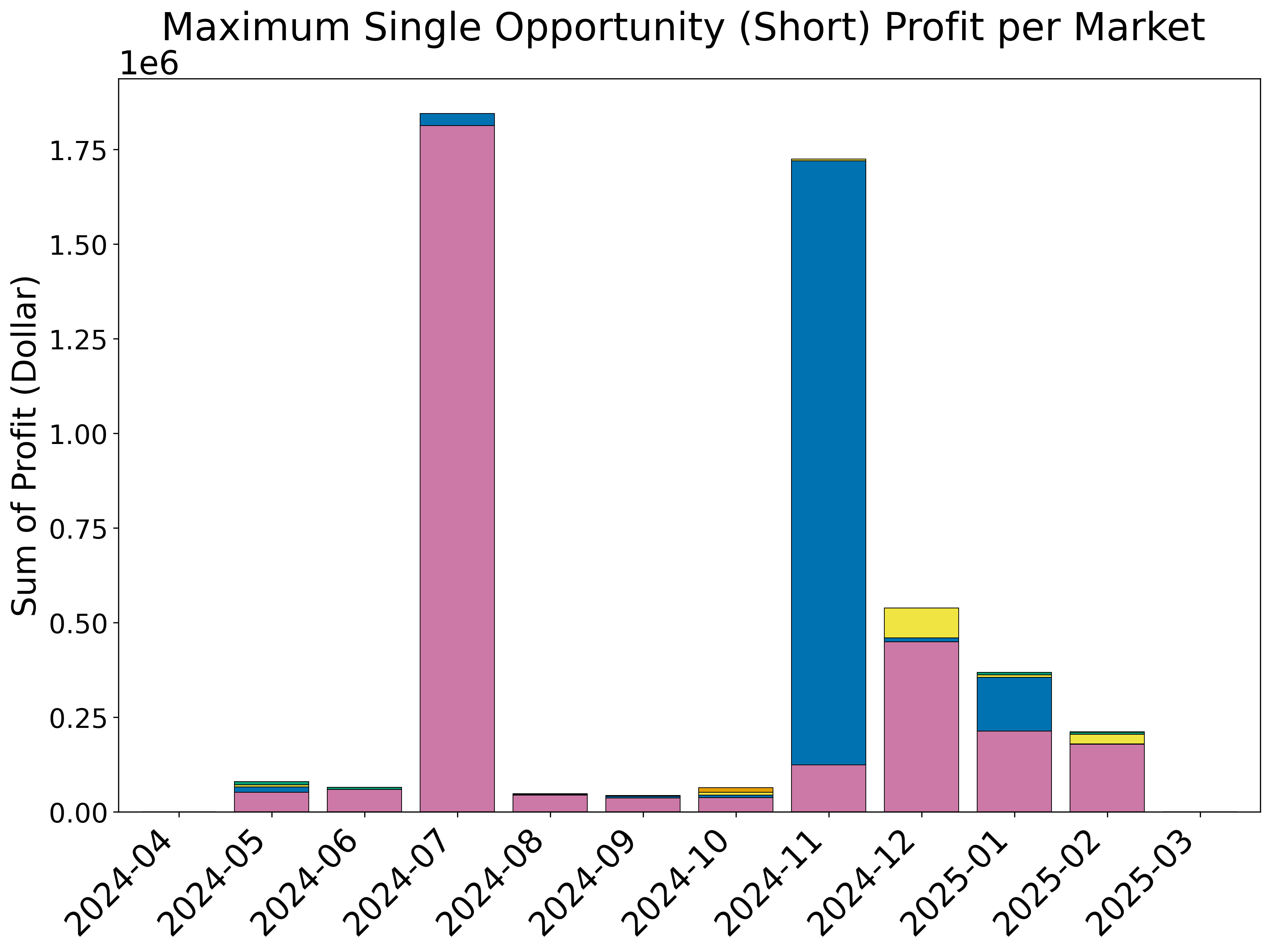
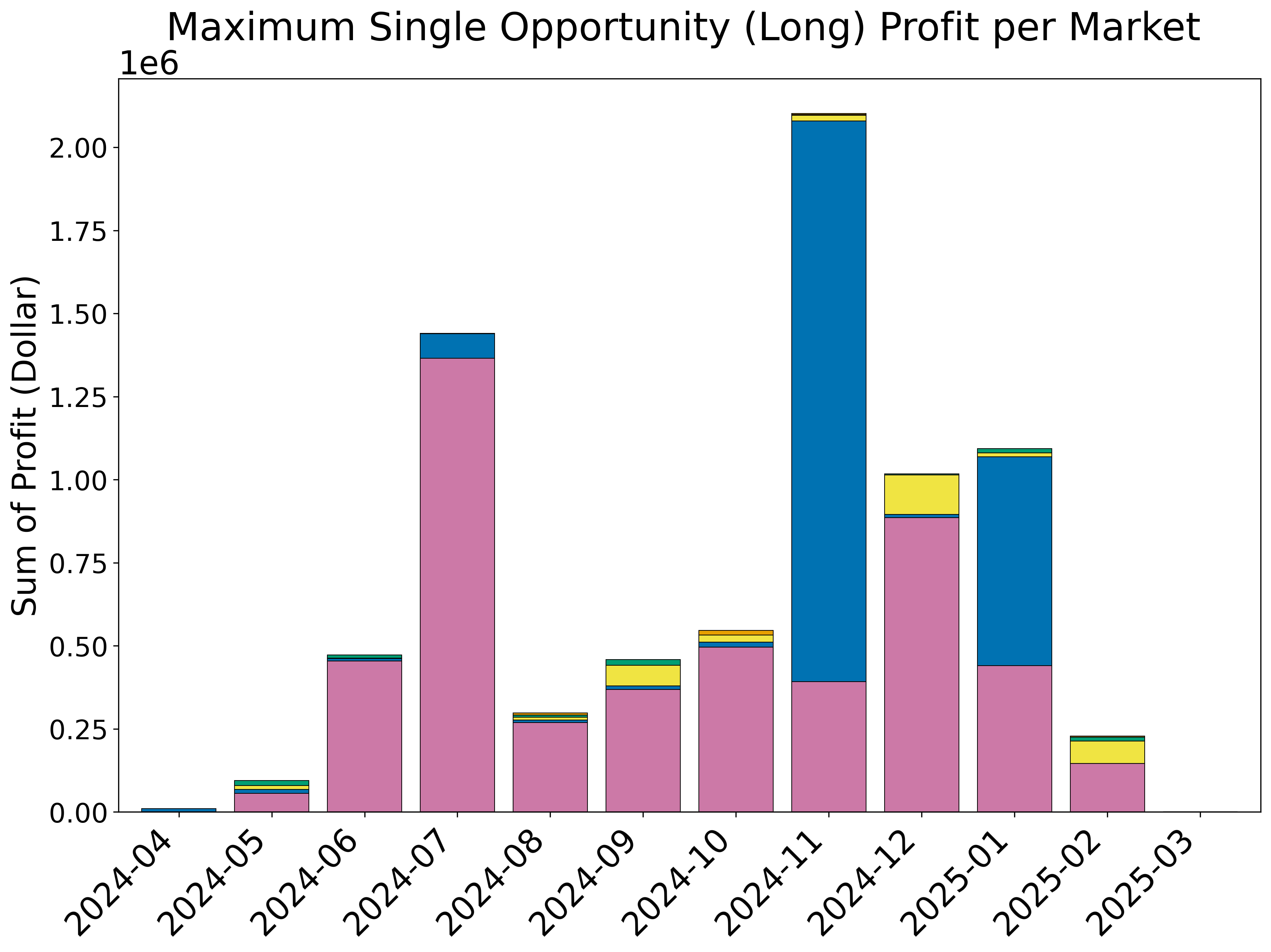
Figure 7: Market-level arbitrage potential, with sports markets dominating long opportunities and politics showing outliers.
Combinatorial Arbitrage Across Dependent Markets
For the 13 dependent market pairs identified, arbitrage opportunities were less frequent and generally lower in liquidity, with average maximum profit around $100 per opportunity. <img src="https://emergentmind-storage-cdn-c7atfsgud9cecchk.z01.azurefd.net/paper-images/2508-03474/pair_arbitrage_bound_0.95_c_0.02_k_1_profit_dollar.png" alt="Figure 8" title="" class="markdown-image"></p> <p><img src="https://emergentmind-storage-cdn-c7atfsgud9cecchk.z01.azurefd.net/paper-images/2508-03474/pair_arbitrage_bound_0.95_c_0.02_k_1_max_profit.png" alt="Figure 8" title="" class="markdown-image"> <p class="figure-caption">Figure 8: Profit per dollar and maximum profit distributions for dependent market pairs in the U.S. election.</p></p> <h2 class='paper-heading' id='realized-arbitrage-and-actor-behavior'>Realized Arbitrage and Actor Behavior</h2> <p>The paper quantifies realized arbitrage by analyzing user bid histories, grouping bids within one-hour windows to account for non-atomic execution risk. Key findings include:</p> <ul> <li><strong>Single Condition Arbitrage</strong>: $5.9M profit from buying below$1, $4.7M from selling above1,withsportsmarketssurpassingpoliticsinexploitedopportunities.<imgsrc="https://emergentmind−storage−cdn−c7atfsgud9cecchk.z01.azurefd.net/paper−images/2508−03474/profitsnegriskbuycolums.png"alt="Figure9"title=""class="markdown−image"><pclass="figure−caption">Figure9:Totalprofitfromsingleconditionarbitrage,withsportsmarketsleadinginrealizedprofit.</p></li><li><strong>MarketRebalancingArbitrage</strong>:11.1M from buying "YES",$17.3M from buying "NO", with politics dominating extracted arbitrage, especially during the U.S. election and Democratic VP pick events. <img src="https://emergentmind-storage-cdn-c7atfsgud9cecchk.z01.azurefd.net/paper-images/2508-03474/profits_combined_7.2_buy.png" alt="Figure 10" title="" class="markdown-image"></li> </ul> <p><img src="https://emergentmind-storage-cdn-c7atfsgud9cecchk.z01.azurefd.net/paper-images/2508-03474/profit_dolar_distribution_by_topic.png" alt="Figure 10" title="" class="markdown-image"> <p class="figure-caption">Figure 10: Total profit and yield distribution for rebalancing arbitrage in NegRisk markets, with politics and crypto as high-yield outliers.</p></p> <ul> <li><strong>Combinatorial Arbitrage</strong>: $60K extracted from the most lucrative market pair, with five of eleven pairs showing evidence of exploitation.
- Market-Level Arbitrage: 662 NegRisk markets had arbitrage, with sports markets consistently offering higher profit, especially in long opportunities.
- Arbitrageur Strategies: Top accounts exhibit bot-like behavior, with the highest profit exceeding $2M and thousands of transactions.

Figure 11: Log-scale plot of bids and aggregate profits across accounts, highlighting concentration among top arbitrageurs.
Implementation Considerations and Limitations
The analysis highlights several practical challenges:
- Non-Atomic Execution Risk: Unlike DEXs, Polymarket arbitrage is non-atomic, introducing execution risk and limiting arbitrage volume.
- LLM Context Limitations: Dependency detection is constrained by LLM input size, necessitating condition reduction and limiting multi-market analysis.
- Market Creation Centralization: The controlled process reduces the prevalence of dependent markets, but the methodology is extensible to more decentralized platforms.
Implications and Future Directions
The findings demonstrate that significant arbitrage exists and is exploited in decentralized prediction markets, with inefficiencies persisting despite sophisticated actors. The LLM-based methodology for dependency detection is robust and scalable, with potential for extension to larger market sets and weaker dependency structures. As prediction markets evolve towards greater decentralization and complexity, arbitrage strategies are expected to become more sophisticated, potentially mirroring developments in DeFi AMMs.
Further research should address:
- Enhanced LLM reasoning for larger condition sets and multi-market dependencies.
- Real-time arbitrage detection and execution strategies under non-atomic constraints.
- Analysis of weaker dependencies and temporal arbitrage windows.
Conclusion
This paper provides a rigorous empirical characterization of arbitrage in Polymarket, combining formal market dependency taxonomy, LLM-based semantic analysis, and on-chain bid data. The results reveal substantial arbitrage opportunities and their exploitation, particularly in politics and sports markets, and underscore the need for improved market design and automated detection mechanisms. The methodology and insights are broadly applicable to future decentralized prediction markets, with implications for market efficiency, actor behavior, and the evolution of arbitrage strategies.
Follow-up Questions
- How does the LLM-based method improve detection of logical dependencies in prediction markets?
- What are the comparative benefits of single-condition versus combinatorial arbitrage opportunities identified?
- How do market creation and centralization influence the prevalence of arbitrage in decentralized platforms?
- What implications do these findings have for the evolution of arbitrage strategies in DeFi and prediction markets?
- Find recent papers about arbitrage in decentralized prediction markets.
Related Papers
- Non-Atomic Arbitrage in Decentralized Finance (2024)
- Automated Market Making and Arbitrage Profits in the Presence of Fees (2023)
- Election Predictions as Martingales: An Arbitrage Approach (2017)
- Improved Price Oracles: Constant Function Market Makers (2020)
- am-AMM: An Auction-Managed Automated Market Maker (2024)
- Quantifying Arbitrage in Automated Market Makers: An Empirical Study of Ethereum ZK Rollups (2024)
- Measuring Arbitrage Losses and Profitability of AMM Liquidity (2024)
- Short Paper: Atomic Execution is Not Enough for Arbitrage Profit Extraction in Shared Sequencers (2024)
- Cross-Chain Arbitrage: The Next Frontier of MEV in Decentralized Finance (2025)
- Measuring CEX-DEX Extracted Value and Searcher Profitability: The Darkest of the MEV Dark Forest (2025)
Tweets
alphaXiv
- Unravelling the Probabilistic Forest: Arbitrage in Prediction Markets (8 likes, 0 questions)